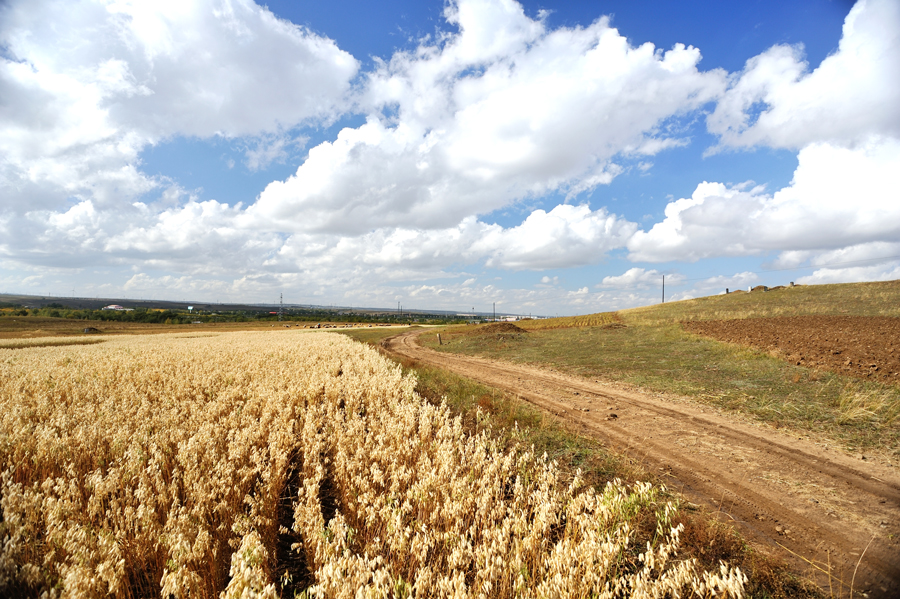Is there a real market for specialist spring cropping?
4th December 2020
With the loss of neonics sending OSR out of favour as a break crop, and more unpredictable weather leading to a dearth of winter plantings in the last couple of years, could one of the more niche spring cropping options be ready to take a prominent place in the rotation? Rachel Hicks reports.

Field of naked oats
At this year’s Cereals LIVE event, consumer interest in different grains, healthy proteins and green energy were cited as the driving force behind the opening up of new specialist crop markets, which was discussed in depth in a webinar chaired by Matt Culley, of the NFU Crops Board.
Contracts are key
Premium Crops managing director Andrew Probert was the first speaker, with the company’s dominant business being specialty crops – in particular, canary seed, linseed and red wheat. According to Mr Probert, alternative crops is a fairly old-fashioned term and relates to any crop which is not mainstream, feed wheat or feed barley – in essence, commodity crops with no added value, therefore Premium Crops prefers the term ‘specialist cropping’.
He suggests that a pertinent question for growers is, ’what are your expectations when growing a specialist crop?’
“Generally, specialist crops are not a commodity, they’re not freely traded,” he explains.
“Often the market sizes are small – some of these crops might only be a few hundred tonnes per year, but they still have significant value and it’s up to the individual growers to make enquiries with the specialist companies like ours to see what the opportunities are out there.” In his experience, with a small market size, often customers are looking for contracted production. This helps to make the supply relatively tight, and it also means they are not over-producing. Being on contract, you are assured that that particular product is going to find a market.
One thing Mr Probert says cannot be stressed enough is that, when growing specialist crops in the UK, we are often displacing imported material. In order to do that, the quality is absolutely paramount. “For example, with canary seed, our buyers are wanting whole seed – they don’t want straw or ergot in it,” he comments. While some producers may argue that the birds won’t mind, Mr Probert points out that the buyers certainly will. Another consideration is that, with a relatively small market, there isn’t the opportunity to move all the product in September, at the grower’s convenience. “A lot of contracts may be for 12–18 months’ supply, in which case we have to manage the o take of the material from farm to that particular customer – different to when you’re producing a commodity crop,” he iterates.
So, what’s in it for the grower? Improved rotational profitability is the key – not individual gross crop margins, reckons Mr Probert.
The primary message here is that contracts are vital, because they ensure you have the right varieties, agronomic back-up, and the confidence that the crop will be produced to the customer’s specification.
Demand for British
Also speaking at the webinar was Agrii innovation crops product manager, Skye Van Heysen.
In Mr Van Heysen’s opinion, there’s clearly a demand from the UK consumer for wanting to buy British and, given that 47 per cent of our food is sourced from abroad, he points out that there’s also the opportunity to address this while increasing self-sustainability in UK agriculture.
With trends towards flexitarian, vegetarian and vegan diets apparent, Agrii aims to rise to these challenges while improving rotational options and potential on-farm profitability at the same time.
One crop they have been trialling is naked oats. Like husked oats, it’s a white straw break crop, with low variable costs. The only difference between naked and husked oats is that naked oats lose their husk during combining.
Mr Van Heysen and his team have put a lot of R&D work into naked oats. While he says there are no silver bullets yet, he comments that it is reasonable to expect gross margins to become competitive as an alternative break crop option. When asked recently for an update on the latest oat trials, Mr Van Heysen said that some valuable lessons had been learnt. Firstly, soil structure is critical because, although oats have an impressive fibrous root structure, they do not have the ability to break through soil pans. His best advice would be to walk your fields with a spade and see if there are any underlying problems. Another note he shared was that, although possibly counterintuitive to most growing systems, spraying to keep the crop clean when disease appears visually absent has delivered marginal yield improvements and better specific weight results. All of this has been trialled against a more traditional way of growing oats and it has delivered positive return on investment.
Another potential opportunity that Mr Van Heysen discussed during the webinar was chickpeas. He reckons the UK market is quite substantial, and Agrii has trialled a series of different varieties across a few years. Recently, the team decided to put pilot crops in the ground, to find out what happens when you move beyond a trial plot, and actually put some serious acreage in the ground.
He is keen to point out, however, that there are some key agronomic issues which need to be addressed such as maturity, and one learning from this last season is that chickpeas are totally unsuited to heavy ground due to the moisture level required. Trials are continuing and knowledge being extended in order to address these issues.
Mr Van Heysen’s final comment is that combinability and marketability are paramount, and in order to make a break crop sustainable on a farm scale, growers need to be able to use the current on-farm equipment and not have to invest in specialist equipment.
Farmers Guide also spoke with Soya UK managing director David McNaughton, who discussed the alternative spring crops that he feels to be on the rise right now.
Birdseed sector
According to Mr McNaughton, in the UK, proso millet (mileum paniceum) is grown – not to be confused with foxtail millet or pearl millet, which are the solid millet sprays you might see in pet shops. The chief market for millet in the UK is the birdseed sector, although there is also interest from the bakery sector.
Market size is the limiting factor, with a maximum possible UK-grown tonnage of around 10,000t. Traditionally, this would be supplied with either French, Ukrainian or Chinese millet, but recent years have seen the development of UK millet production, he reckons. With yields ranging from 2.5–4.7t/ha, an average yield is usually around 3–3.5t/ha. This means there is often a few thousand acres of contract available, but the size of the market is a limiting factor, and it is common for contract providers to be oversubscribed with potential growers.
Millet has a number of advantages in that it is very easy to grow, will grow virtually anywhere, including on poor soil, and is highly resistant to any pests or diseases. Agronomy is very straightforward and usually consists of sowing the crop, giving it some N, and killing the weeds with some basic approved broadleaf herbicides.
With a late sowing window of early May, it is often seen as a “get out of jail” crop, Mr McNaughton says, with it often being used to patch in failed oilseed rape.
Soya developments
UK-grown soya is on the up, says Mr McNaughton, with Soya UK Ltd announcing a strategic cooperation with Naturasoy – part of AB Mauri, who are a division of Associated British Foods plc.
AB Mauri produces yeasts and technical bakery ingredients, with soya our being an important ingredient in its portfolio.
This co-operation gives UK soya beans the guaranteed, large-volume, high-value market it needs to thrive going forward, and from harvest 2020, a large proportion of UK soya beans will be going to this market. According to Mr McNaughton, British soya has a guaranteed market for at least 10,000ha of production at the premium end of the market, and so his aim is to increase the acreage from 2,000ha up to 10,000ha as soon as possible.
Previously, UK-grown soya had almost no approved chemistry, making weed control difficult and expensive. Nowadays, the situation has turned around, with most other break crops rapidly losing chemistry, while soya has been gaining it.
Mr McNaughton explains: “Not only can we use normal pea and bean chemistry, but also some notable additions. For example, on pre-emergence weed control, it is possible to use Nirvans, Stomp and Gamit (as you might on peas or beans), but also Artist – which contains ufenacet, and greatly increases the effect on black-grass. If we add this to the fact that soya is planted in the late spring, and post-emergence graminicides can also be used, then this makes soya one of the best crops for suppressing black-grass in the rotation. On post-emergence broadleaf control, the story is also much improved, since not only can growers use Basagran, they can also use Pinnacle (thifensulfuron).”
One of the biggest carbon inputs of any arable farm is nitrogen fertiliser, and one of the most effective ways of reducing fertiliser use on farm is to grow leguminous crops. Soya is a very good nitrogen-fixer, plus, because soya is rotationally compatible with peas and beans, growers can continue their normal pea or bean acreage whilst adding soya as an additional legume. This is very good news for growers, since increasing the area of legumes on farm will be a key part of ELMS management.
“With the backing of Naturasoy, and UK soya commanding a decent non-GM premium, the gross margins stack up well. This, along with the agronomic developments, and the rotational bene t of soya makes it a new option worth looking at for many arable farmers,” comments Mr McNaughton.
Green shoots for lupins
According to Mr McNaughton, lupins are an excellent break crop, but have been dogged over the years by two distinct problems – namely weed control and lack of markets.
Thankfully there are some green shoots of hope on both these fronts, making lupins potentially more viable.
On agronomy, the situation has been improved by the crop now having a range of approved pre-emergence herbicides, and the presence of an EAMU for the use of Lentagran post-emergence.

Field of white lupins
This means that lupins now have a weed control programme that is at least as good as spring beans.
The other issue is a lack of market. This has been the major limiting factor for lupins over the years, but recently Frontier has been placing contracts for lupins for the sh feed market, giving it a slight boost.
The crop is productive and gross margins would be attractive for growers. If the market was there, lupins would be a popular crop in the arable regions of the UK.
Also, like soya, lupins are effective nitrogen-fixers, and they are rotationally compatible with other legumes, so potentially a key part of ELMS management.
For livestock farmers who are looking for a soya replacement, then lupins could be the perfect answer for this, Mr McNaughton reckons. They produce a high-quality protein which is capable of replacing the quality amino-acids normally associated with soya meal. “With no need for a market, the home-use grower can really benefit from growing this crop,” he concludes
